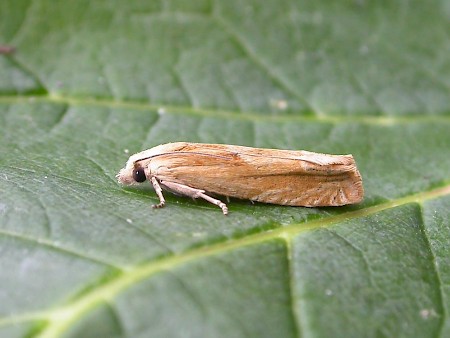49.267 BF1200b
Fulvous Bell Eucosma fulvana
Stephens, 1834
Once thought to be reasonably widespread throughout the British Isles, our picture of the Fulvous Bell’s distribution has become muddied since its split with E. hohenwartiana. Both species are found in open habitats such as meadows, rough grassland and road verges.
The Fulvous Bell especially frequents areas where its preferred foodplant, greater knapweed, is known to grow.
Larger and paler than E. hohenwartiana, the Fulvous Bell has a mottled, dull to rusty brown appearance. The front edges of its forewings are striped with narrow white bands. Below these bands, on each forewing, is a partially formed, silvery-white eyespot encircling several small black dashes. Hindwings tend to be lighter in colour and are trimmed with a small fringe of whitish cilia. This species can be most reliably distinguished from E. hohenwartiana by examining the genitalia in female moths.
Adults are on the wing from June to August, laying their eggs during this period in the flower heads of greater knapweed. The hatched larvae have light brown heads and pale yellow to pinkish bodies. After a summer of feeding on the seeds of their foodplant, they head for the ground. There, under the warm shelter of leaf-litter, the larvae spin silken cocoons for hibernation. With the arrival of spring, they pupate.
Description: Michela Sisti

 UKMoths
UKMoths 

